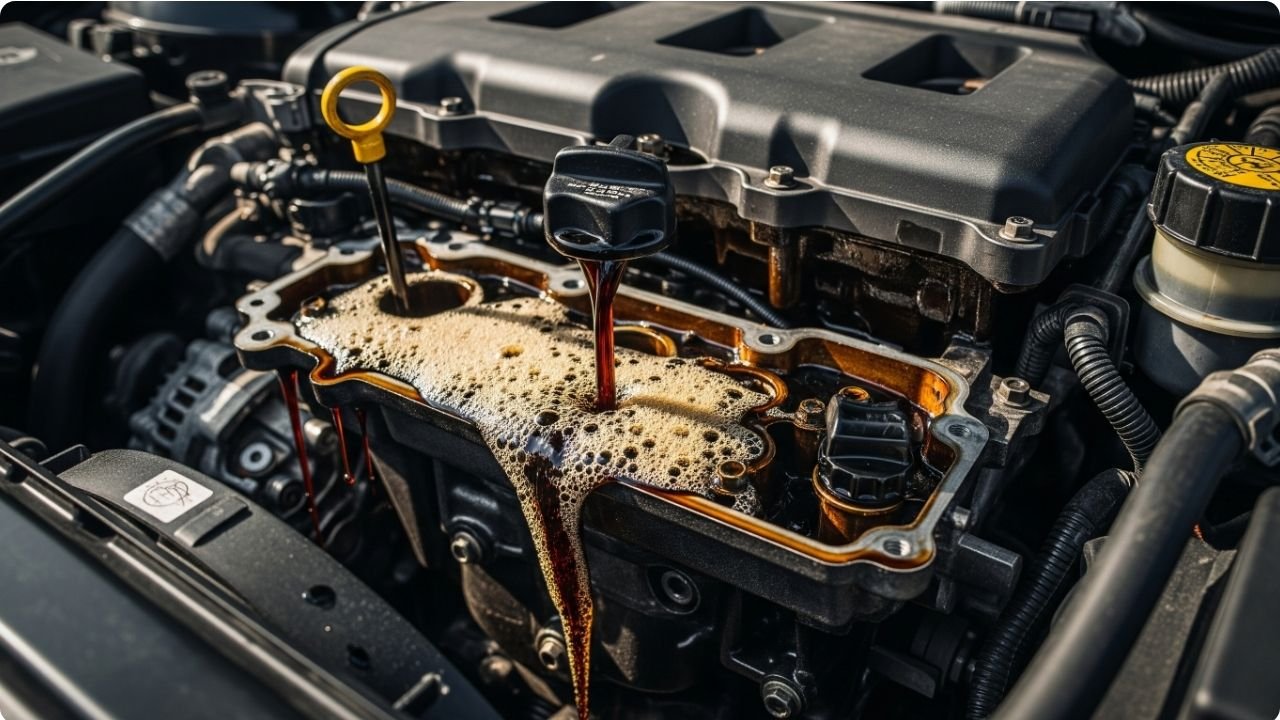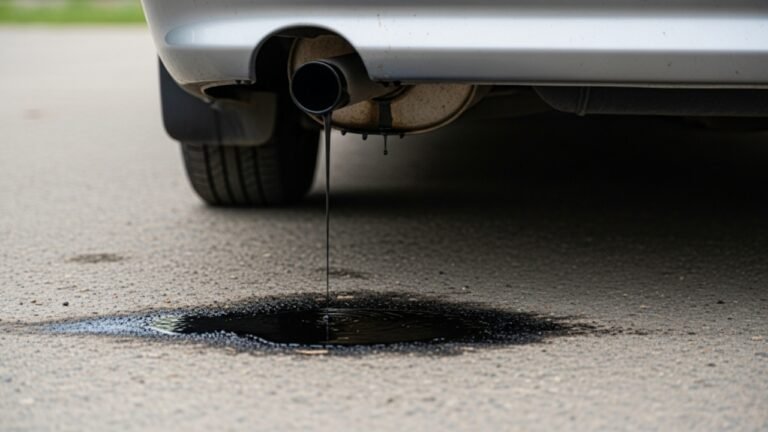What Happens If You Add Too Much Oil to Your Car?

Let me start with a little story. I remember one rainy morning in Dhaka when I thought I was doing my car a favor. I had just changed the oil, and in my enthusiasm, I poured in a little more than necessary. “Better safe than sorry,” I told myself. What could possibly go wrong?
Turns out — a lot.
Adding too much oil to your car can do more damage than skipping an oil change. It might seem harmless, even thoughtful. But overfilling your engine oil can lead to strange noises, thick white smoke, oil leaks, or even complete engine failure. That’s not just a mechanic’s horror story — it’s something that can hit anyone who owns a car.
In this article, we’ll break down what actually happens if you add too much oil to your car, how to spot the symptoms, and what you should do if it’s already too late. I’ll walk you through the science and the signs using plain language, real-life examples, and a healthy dose of storytelling — just like you and I are sitting over a cup of tea, talking shop.
Let’s dive right in.
How Much Oil Is Too Much?
Before we talk about problems, let’s understand the numbers.
Your car’s engine is designed to hold a specific amount of oil — not more, not less. Think of it like cooking rice. Too little water, and it burns. Too much, and it becomes a soggy mess. Oil is your engine’s lifeblood, but too much of it throws off the balance.
Here’s a simple guide to help you understand:
| Engine Size | Typical Oil Capacity | Overfill Danger Zone |
|---|---|---|
| Small Engine (1.0–1.6L) | 3.5 – 4 liters | Over 4.2 liters |
| Mid-size Engine (1.6–2.5L) | 4 – 5 liters | Over 5.5 liters |
| Large Engine (2.5L+) | 5 – 7 liters | Over 7.2 liters |
You might think adding half a liter more doesn’t matter — but modern engines are more sensitive than ever. Even a small overfill can lead to serious engine performance issues.
The Engine Oil’s Job: Why Balance Is Everything
Before we get into the damage, let’s remember what engine oil actually does.
Oil is like a silent housekeeper. It:
- Lubricates the moving parts of the engine.
- Reduces friction, keeping things cool and smooth.
- Carries away debris, metal shavings, and dirt.
- Helps seal tiny gaps between pistons and cylinders.
- Aids in engine cooling along with the coolant.
So, what happens if you add too much oil to your car? It starts to foam and aerate, making it lose its lubricating properties. It’s like whipping cream — too much air, and it’s no longer liquid. Your engine parts end up rubbing against each other without proper lubrication, creating heat and wear.
That’s when things start to go wrong.
Symptoms of Overfilled Engine Oil (Listen to Your Car)
You may not realize you’ve added too much oil until your car starts acting weird. The engine doesn’t speak — but it sure knows how to groan when it’s in pain.
Here are the most common signs that you’ve overfilled the oil:
- White or blue smoke from the exhaust – Looks like your car’s vaping. This happens when oil leaks into the combustion chamber and burns.
- Strong burning oil smell – You might catch a whiff of something off, especially at stoplights.
- Oil leaks under your car – Seals can burst due to pressure, leading to puddles on your driveway.
- Engine knocking or rattling – Foamed oil doesn’t lubricate, and metal parts start hitting each other.
- Check engine light – Often ignored but one of the earliest warnings.
- Poor acceleration – The engine feels like it’s dragging a bag of bricks.
Personal tip: If you hear a weird ticking or knocking sound and recently topped off your oil, check your dipstick immediately.
What Happens Mechanically: Damage Inside the Engine
Now let’s get technical, just for a moment — but I promise, it won’t be boring.
When you add too much oil to your car, the excess oil gets whipped up by the rotating crankshaft. This causes aeration — meaning air gets trapped in the oil. Aerated oil loses viscosity and becomes bubbly and less effective at lubricating.
Here’s what happens inside your engine:
- Foamy oil can’t coat engine parts properly.
- Increased pressure can blow out seals and gaskets.
- Oil might reach places it shouldn’t — like the spark plugs or catalytic converter.
- The crankshaft faces resistance, making the engine work harder.
- Over time, this can cause bearings to wear out, rods to bend, or even complete engine failure.
Imagine trying to run a marathon in sand instead of on a track — that’s what your engine feels when oil is overfilled.
Personal Story: When I Overfilled My Engine
Let me confess something. I once overfilled my dad’s Toyota Corolla by nearly a full liter. I was young, cocky, and trying to impress him by “doing the maintenance myself.” A week later, the car started smoking like a chimney, and the engine ran rough.
We took it to a local mechanic, who simply looked at the dipstick and shook his head. He drained the excess oil, replaced the oil filter, and the car thankfully survived. But it cost me two full days of anxiety and a very humbling lecture.
What I learned that day was simple — check, don’t guess. Always use the dipstick before and after adding oil.
How to Check If You’ve Overfilled Oil
It takes two minutes — and could save your engine.
Here’s how to do it:
- Park on a flat surface and wait for the engine to cool down.
- Pull out the dipstick, wipe it clean, and reinsert it fully.
- Pull it out again and check the oil level.
- If the oil mark is above the MAX line, you’ve added too much.
If the oil is just a little over, you may be safe. But if it’s significantly over — act fast.
What To Do If You’ve Overfilled the Oil
So you’ve confirmed it — the oil level is too high. What now?
Here are a few ways to fix it:
- Drain excess oil using the oil drain plug underneath. If you’re handy, this is the best way.
- Use an oil extractor pump from the dipstick tube. This is cleaner and simpler.
- Visit a mechanic if you’re unsure. It’s safer than guessing.
Also, replace your oil filter if it got contaminated. And don’t forget to dispose of the excess oil properly — not in the drain!
Long-Term Damage from Overfilled Engine Oil
If you ignore the problem and keep driving, the consequences get worse. Slowly, engine wear becomes irreversible. You may not notice anything at first — until it’s too late.
Here’s what long-term damage can look like:
- Worn-out piston rings: The excessive pressure forces oil into the combustion chamber, damaging the piston seals. This can lead to oil burning and loss of compression.
- Clogged catalytic converter: Burned oil leaves residue inside the exhaust system. Over time, your catalytic converter can fail, which is expensive to replace.
- Spark plug fouling: Oil seeping into the cylinders fouls the spark plugs, causing misfires or poor starting.
- Permanent oil leaks: Overpressure can deform the seals and gaskets, creating leaks that never fully go away.
- Hydro-locking (in extreme cases): When too much oil enters the combustion chamber, it prevents the piston from moving. This can break rods or crack the engine block.
All this from something as innocent as adding a bit more oil than needed.
Oil Pressure vs. Oil Volume: A Delicate Dance
People often confuse oil pressure with oil level. But they’re different — and connected.
Oil pressure is the force that pushes oil through the engine. It keeps all parts moving smoothly and reduces friction. But when there’s too much oil, the pressure can drop or spike. Why?
Because foamed or aerated oil moves unpredictably. Sensors can’t read it right. The oil pump struggles to circulate it properly, especially when bubbles get trapped. That’s when your check engine light may come on, or worse, the engine could start to starve for oil despite being “full.”
Too much oil = unpredictable pressure = engine stress. It’s a domino effect.
Prevention Tips: How to Avoid Overfilling Your Engine Oil
The best way to avoid this problem? Don’t let it happen in the first place.
Here are some practical tips you can follow:
- Always check the dipstick before adding oil. Don’t rely solely on “gut feeling.”
- Read your owner’s manual. It will tell you the exact oil capacity.
- When topping up, add in small amounts. Wait a minute, then re-check the dipstick.
- Use a funnel to avoid spills and guesswork.
- Get your oil change done at a trusted garage or do it yourself with a measuring jug.
- Mark your next oil change with a sticker or app reminder. Overfilling often happens when people forget they already added some earlier.
- If you’re uncertain about the level, wait and check again in the morning. Cold oil settles more clearly.
Remember: it’s easier to add more later than to remove the extra later.
The Science Behind Foaming Oil (Quick & Simple)
Let’s break down the technical part with an easy metaphor.
Imagine blending mango juice in a blender. If you fill it too much and turn on the motor, it creates froth. It bubbles, splashes, and loses its consistency. That’s exactly what happens when your crankshaft spins through too much oil.
Foamed oil = inconsistent lubrication.
Foam rises, gets sucked into places it doesn’t belong, and your engine’s performance begins to crumble. And because the oil pump is built to handle only liquid oil, it chokes when it gets bubbles. That leads to dry parts, increased heat, and engine strain.
So while it may sound like “just a little extra oil,” it ends up causing chaos under the hood.
Common Myths About Overfilling Oil (Don’t Fall for These)
Let’s clear up some popular myths:
“A little extra won’t hurt.”
Even 200-300ml extra can be harmful in newer cars.
“Oil will burn off naturally.”
Yes — but not before damaging your catalytic converter or spark plugs.
“My car’s running fine, so it’s okay.”
Symptoms may not appear immediately. Long-term wear is slow and sneaky.
“Mechanics overfill all the time.”
A good mechanic will never overfill. If they do, ask them to correct it — politely but firmly.
“Thicker oil means better protection.”
Not necessarily. Too thick or too much oil slows circulation and hurts cold starts.
Don’t base your decisions on internet rumors or roadside advice. Always trust the data, your manual, and your dipstick.
FAQs: Your Questions, Answered Clearly
1. How do I know if I added too much oil to my car?
Check your dipstick. If the oil level is above the MAX mark or smells burnt, it’s too much. You may also see smoke, leaks, or poor performance.
2. Can too much oil damage the turbocharger?
Yes! Excess oil can leak into the turbo, causing carbon build-up or even a turbo failure, which is a costly repair.
3. How do I fix overfilled engine oil without tools?
You can use a hand pump extractor from the dipstick tube. It’s a bit slow but effective. Otherwise, visit a mechanic for a quick drain.
4. Will driving a short distance with too much oil hurt my car?
Short-term, maybe not — but it depends on how much excess oil you added. If it’s significantly overfilled, don’t drive. Drain it first.
5. Is it safe to remove excess oil myself?
Yes — but be careful. Use gloves, protect the engine bay from spills, and dispose of used oil safely at a recycling center.
6. How long does it take for overfilled oil to cause damage?
Sometimes immediately (like blown seals); sometimes over weeks (like spark plug fouling). Don’t take the risk. Fix it right away.
7. Can oil overfill cause misfire?
Yes. Oil can reach the spark plugs and cause misfires, especially in smaller engines with tighter tolerances.
8. What if the oil is only slightly overfilled?
If it’s just 2-3mm above the max line, monitor it closely. But if you’re unsure, extract a little to bring it back to safe levels.
Final Thoughts: Treat Your Engine with Respect
At the end of the day, your car is more than just a machine. It’s a part of your daily rhythm. It gets you to work, helps you run errands, and sometimes — takes you on spontaneous road trips when life feels too heavy.
So take care of it like you would a loyal friend.
Adding too much oil to your car may seem small, but it’s one of those things that snowballs. What starts as a harmless overfill could end in engine damage, expensive repairs, and regret.
The next time you’re under the hood, pause for a second. Breathe. Check your levels. Respect the numbers.
Because in car care — more isn’t always better.






